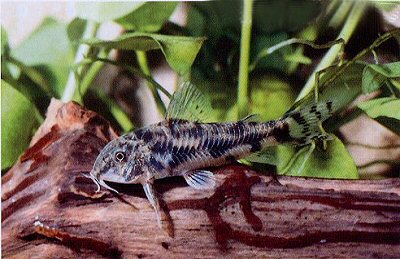SCOTCAT.COM
your internet guide to all things catfish
| Aspidoras maculosus |
by Bill Bishopp |
Aspidoras maculosus
Those that I have seen are small, 2 to 2 1/2 inches in length (5 - 6 cm). They have relatively small eyes when compared to Corydoras. They tend to be fairly slender, and the males and females can be hard to distinguish. Most are covered with black or grey blotches on a whitish background. In fact, they look a lot like male Corydoras paleatus (the Peppered Catfish). The females tend to get a little more plump, but this is not as obvious as with Corydoras. As with Corydoras, Aspidoras are quite peaceful. I have found that A. maculosus is a little more skitterish than Corys, however. They would do well to have a little cover, or a place to escape to. They definitely do better in groups of at least a half a dozen, and they tend to stick together. Also, if you purchase a small group, you are more apt to get some of each sex. Feeding Aspidoras is pretty much the same as with Corydoras. They take all foods I have tried including flakes, brine shrimp (adult frozen and baby), beef heart, Tabi-Min, etc. They are bottom feeders so one has to be sure they get their share in a community setup. I obtained about a half-a-dozen a little over a year ago at a club auction, and placed them in a 5 gallon tank. The tank contains a sponge filter, some java moss, and water sprite floating on the surface. As these were close to adults, I gave them a bottom mop to spawn in, in addition to the jave moss. After several months, however, no eggs were found in the mop or on the glass. Then one day I found 3 eggs on the front glass near the surface of the water. These were removed and placed in a small tank with a sponge filter. They hatched and grew without difficulties. As they were not enough for our Breeder's Award Program, I gave them away as soon as they were big enough. The experience made me think, however, that maybe they needed a floating mop. So I placed a killie mop with a cork on top in the front of the tank where I could watch. Within a week I found a few eggs on the glass behind the mop facing the front. An inspection of the mop revealed many more eggs hidden in the upper portion of the mop. The mop and eggs were again placed in a 1 1/2 gallon tank with a sponge filter. The sponge filter has a short stem so the water level can be kept low, also the filter has a small stone under one edge so the fry can go under and not get stuck. After about three days the eggs hatched. Another 2 to 3 days were required for the fry to absorb their yolk sac. At that time they were fed. They took the usual fry food without difficulties and were easily raised. My fry get a banquet of a squirt of infusoria, some vinegar eels, some microworms, and very few baby brine shrimp. Very small servings of each are given to prevent pollution. At this point I also introduce some small snails to clean up whats left. As soon as I see they are going after the brine shrimp (by their pink bellies), I discontinue the other foods. When they are about 1/2 inch in length, they get some powdered dried food. I have found that A. maculosus are quite easy to raise under these conditions. I have not tried to start them in small margarine containers, so I don't know if it will work. My fish definitely prefer a floating spawning mop. In the last spawning, consisting of 17 fry, only 2 eggs were on the glass. And these two were right next to the mop. This makes it very convenient, as the mop is easily removed to another container for hatching. I find these a delightful
little cat. They should make a nice addition to a
small community tank. |
If you would like to contribute an article, please e-mail me. You will of course be credited for your work.
If you would like to donate any denomination of money to the site just click the above link button. All proceeds will go to running the site and hopefully to keep it going for a few years yet.
Print or e-mail this factsheet below


